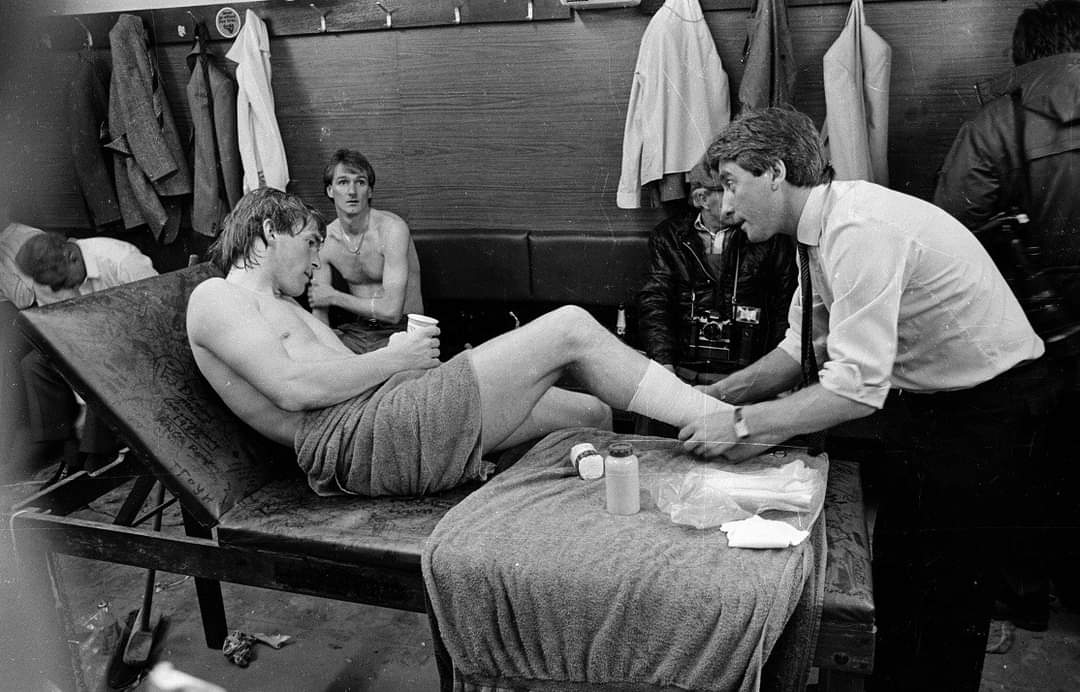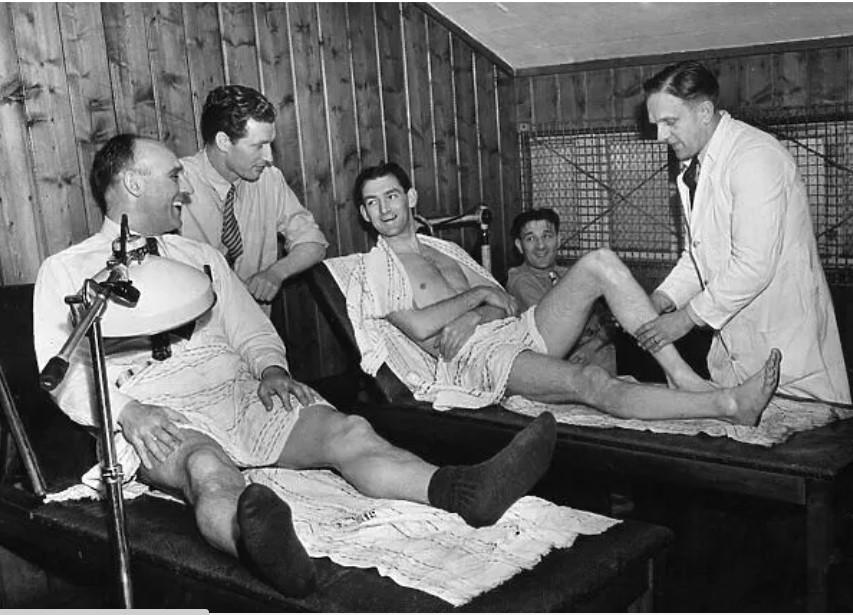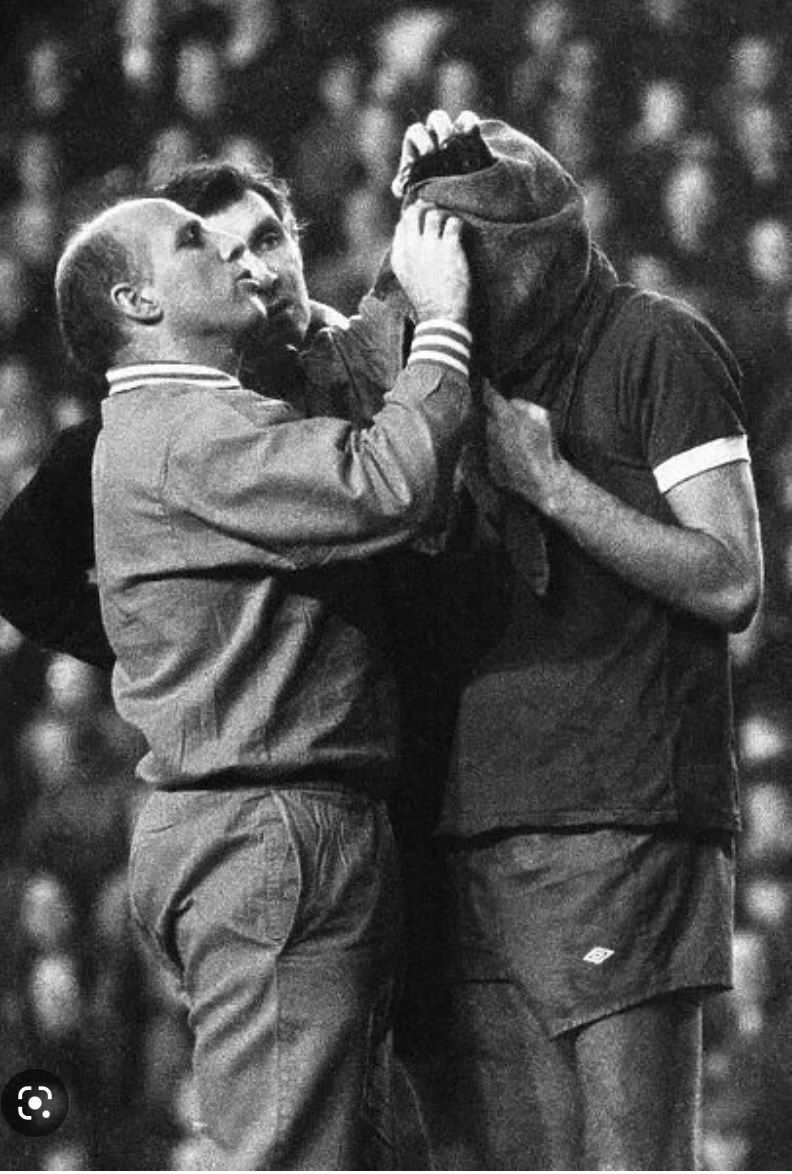Articles
Melwood To Moenchengladbach - The Medical Auxiliaries of Liverpool Football Club
Gavin Blackwell, the author of this article, has spent his career working as a physiotherapist for a series of non-league clubs, including Oldbury United, Bilston Town, Stourbridge, Hednesford Town and Halesowen Town.
Over to Gavin:
The Boot Room men of Liverpool Football Club and everything they stood for that inspired me in both coaching and medical and being part of a backroom team in football. I have always carried the motto "Working for a football club", in whatever capacity is not so much a job rather a way of life. Your title or job description defines a very narrow view of your function, and the broader application of being a member of the staff team is probably more accurate, as it covers the small day to day problems that crop up when dealing with around 20 people people which is what players are. Bill Shankly and Bob Paisley preferred the word staff rather than titles.
Liverpool Football Club has been fabled in many ways for its success and great teams, looked upon in high regard is the Boot Room known for being football brains trust where a small group of men wore red but traded in gold and silver. The game today evolves more around its data, analytics, stats and with its all encumbering term of sports science, not forgetting the huge advance in football medicine. Albert Shelley, Bob Paisley Joe Fagan, Ronnie Moran and Roy Evans played a significant part in the medical standards and levels at Liverpool. Although not medically qualified, they was what you would term auxiliaries of the wider specialism. Not only in First Aid and diagnosis but also treatment, rehabilitation of injuries and maintaining fitness of players, Bob’s background was trainer to physio to assistant manager and then manager. He could diagnose an injury sitting in the directors box long before Moran gave treatment. A player would go down a certain way and Bob would say “That’s a six-weeker “ and nine times out of 10 he would be right. So what they would make of today's sports science I am not quite sure.

Bob Paisley with the most modern equipment of the day
Bob was the first to highlight that it is much more than a Magic Sponge, an art over science, in an article that appeared in the Liverpool Echo in January 1974. Liverpool always had a reputation for getting players fit and keeping them that way. It took years of hard work and adaptation to device a formula which ensured that players chalked up hundreds of first team appearances over the years. Like the headline of the article. Fagan, Moran and Evans followed each other in doing the run duties to treat players on the pitch and during the week in the the role of first team trainer. They became noted for innovative ways to keep players fit. Liverpool became noted for their ‘magic box’ too, a portable piece of apparatus which could provide electrical treatment for injuries. They would take it anywhere; into hotel rooms as well as treatment rooms and it could give half a dozen different types of treatment, according to the injury. One of the beauties of being able to give effective treatment is that the injury heals properly. Another aid to treatment was the whirlpool - water massager--it was like a big bath, and you immersed the injured part of the body in it while the water was kept constantly at body heat.

Roy Evans bandaging Kenny Dalglish
The job of physiotherapist and trainer occupied a seven-day week existence including Sundays and it involved medical knowledge and little psychology. Those principles and treatments involved cold therapy. Many a return journey following away games was spent in the guard’s van on trains armed with buckets of ice cold water, and applying cold compressions to injured players to reduce the swelling in the quickest time especially with a big game looming. When Ronnie Moran was a player, Albert Shelley had been the in-house physio whose healing ways were often quite rudimentary, as Ian St John remembers: “The remedy to reduce swelling of ankles and knees most favoured by Albert was hot and cold towels. He would have two towels in two buckets, one hot and the other one filled with ice and alternate between hot and cold."
Depending on the level of injury who ever was first-team trainer and the coaching staff would attend those who picked up injuries on a Saturday in the treatment room at Anfield, usually on a Sunday morning. Fagan, Moran and Evans could tell if injuries was serious or not and the more serious were sent to hospital or to a part-time consultant chartered physio by the name of Paul Chadwick who Kenny Dalglish had appointed.
The diaries will testify
THURS FEB 14th (Ian Rush) Lt Ankle ULTRA SONIC (6mins),
THURS APR 11th J WARK (Lt Knee ICE (20 mins)
FRI APR 19th J Beglin (CALF) INTER (30) Hot baths, stretches and so on.

Albert Shelley tends to Phil Taylor in 1951 with Paisley looking on
You could often almost immediately see what the trouble is and work out what to do, but sometimes, you had to let nature take its course and take it slowly, no mater how impatient the player may be to see his name on the team sheet again. Liverpool had a club doctor on hand for cuts to do stitches, assess head injuries and similar cases, but would defer to various specialists if in doubt. Liverpool had developed this reputation of getting players fit from injury on a game to game basis. So much so that when Graeme Smith become head of Sports Medicine at The FA based at the newly formed National Sports Injury and Rehabilitation Centre at Lilleshall, he wrote to Liverpool hearing the standards and reputation they had. On the back of the Liverpool way and insight, a minimum level of qualification was set and devised in the form of The FA Diploma In The Treatment and Management Of Injuries; a two year course replacing the old certificate with distance learning with a two 12 day learning residential block split in to Part A and Part B. Smith, who was chairman of the Chartered Society Of Physiotherapy later set up an organisation known as The Society Of Sports Therapists. This would give those in clubs a status and standards of working in line similar to chartered physio. In a recent interview on Life Stories for Physiquipe Graham Smith paid a glowing tribute and highlighted the craft of those medical auxiliaries that served the club so well.
Liverpool covered all the bases at both Anfield and Melwood. Good basics was key. Pre-season would always start with standard height and weight measurements. Everything was planned and structured to prepare players who could turn out in a 50-plus game season. What it did it meant Liverpool would more than meet the intensity of those fixtures along with travel, hotels and killing time.

Ronnie Moran was quick to nurse his players
I often look back to that article in the Liverpool Echo the headline "It’s Not Just A Magic Sponge", accompanied by a picture of trainer Bob Paisley in his Anfield treatment room with all the electrical equipment they used, from shortwave, ultrasound heat lamp and hot water bottles. The trainers would also rely on the contents of those bright yellow Gola trainers bags and the items of the medical skip they took to every game.
I am often asked what’s been the changes in the treatment of soft tissue or sports injury over the years. The temptation to quote the old saying; “The more things change, the more they stay the same” comes to mind. Things have, though, come a long way in the medical side of football as along with chartered physios with masters degrees, club doctors and consultant surgeons are educated specialists with diagnostics and surgical skills which facilitate the work done in the treatment room. The progress in surgical procedures such as arthroscopy and ACL reconstruction (anterior cruciate ligament) for example have cut down the post-operative physiotherapy dramatically. But, no matter how much techniques, facilities, budgets and the nuts and bolts change… you still need the right people to implement these and motivate the players through a sometimes difficult and desperate period in their career. Paisley described the essential qualities required in a good trainer, “a combination of everything”. He has to have expert medical knowledge, immense football experience, be quick and alert in summing up every conceivable situation, both on and off the field, and when it comes to an injury he must also be something of a psychologist. You have to know your players inside out. Some are high-morale, some are low morale. Some need an arm around the shoulder. What is important Is that you regard them not so much as footballers but, with a medical man's eye as individuals."

Joe Fagan with Ray Clemence on the treatment table in 1976
There was a significant change in procedures at Liverpool when Graeme Souness took over. Ronnie Moran, a stalwart of the boot room described the changes in The Boot Room Boys Inside Anfield by Stephen F Kelly. "Graeme had his own ideas. He made these changes but we didn’t say, ‘Hey, you can’t make these changes.’ because he was manager. He changed the boot room, got a new place we have carpeted but it’s got no boots in." Souness also introduced a new occupant to the boot room; Phil Boersma who had been Souness' teammate at Middlesbrough and Liverpool and had later joined his staff at Rangers. Boersma had trained and qualified as a physio and now did the treatment, making it uneccessary for Moran to come in on Sundays. It was safe to say that life at Anfield would never be the the same again. The boot room was no more, the end of an institution, but never forgetting that the principles remain, forever etched on Reds' minds with the statue outside of Anfield.of Bob Paisley carrying Emlyn Hughes off on his back following his gashed knee without any drama or histrionics.
Following the departure of Souness and Boersma, Roy Evans brought in Southport Physio, Max Thompson, to hold the fort in the treatment room. In the close season Roy Evans appointed Liverpool's first full-time chartered physio former Brighton. Preston North End and Burnley Physio, Mark Leather. It remained a backroom staff built along classic boot room lines: like-minded low--risk men working towards a common goal codified by the manager. But they understood the mantra of always sticking together and backing the manager once decisions have been made.
Article written by Gavin Blackwell for LFChistory.net


